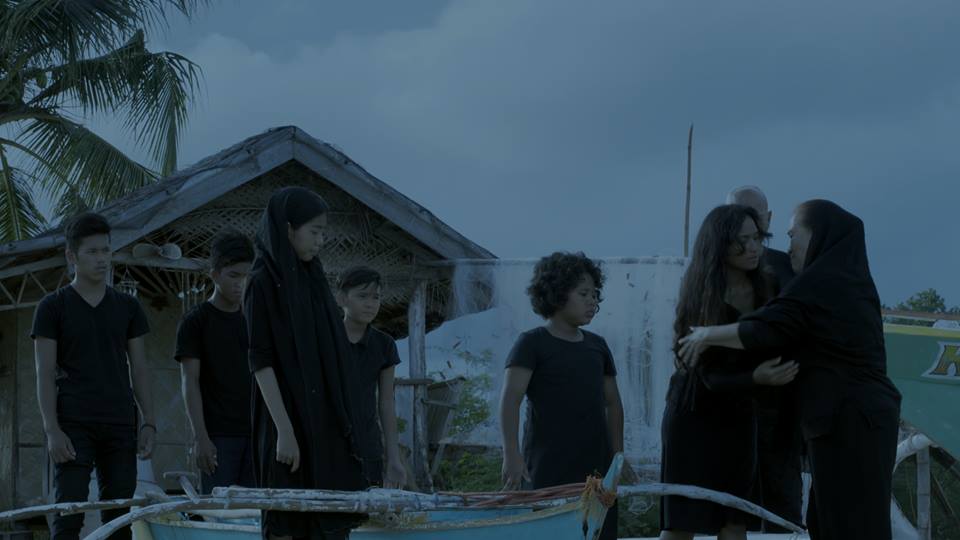As dawn starts to creep in the horizon, we see the silhouette of Divina (Elora Españo), with a spear on her hands, standing in a the sea waist-deep. She’s sizing up the water, cautious not to make any unnecessary commotion. But no amount of concentration can make this a day of successful catch for the sea is a wise character itself. It may be deceivingly set and calm on the surface, but once the spear is struck, the fish turn out to be surprisingly scarce at the moment.
That opening scene of Joseph Israel Laban‘s Baconaua (Eng. trans.: Sea Serpent) unwittingly symbolizes the structure of the film for its viewers. It pleads for patience, promising you a big epiphany in its final moments. Alas, after you build your expectations that it’s going to lead to something great, you instead end up scratching your head, wondering if there’s something you missed. Somewhere in the depths of the ominous sea, the legendary, metaphorical sea serpent slumbers; its dormant strength begs to be tapped by the narrative.
Set in a gloomy island of Marinduque, Divina, along with her siblings Dian (Therese Malvar) and Dino (JM Salvado) are faced with a dilemma of whether to declare their father officially dead after being missing for ninety days. “The sea never returns what it’s taken,” a resident says, and from that statement, we learn that death in this form has become a norm. The film does not really dwell on this loss as the narrative moves on immediately. The next morning, an overnight squall turns the sea red, a reference to Revelation 8:8 as quoted in the beginning of the film. The biblical metaphor isn’t as effectively communicated through its visuals as the cinematographic choice of desaturating the image doesn’t make anything look red. The floating objects meant to be apples instead seem to be black chunks of trash. It’s not until someone takes a bite out of one of them that you realize what they are.
The film also hints at a theme of post-colonialism. The Spanish and American renditions of the Philippine national anthem play over the radio seemingly as a way to reference the country’s history. This little detail forebodes an arc by the middle of the film involving a foreign smuggler. While the film does its best to tie everything together in the end — this, the biblical allegories, the Visayan mythology — none of them mesh too well. The different themes feel too disjointed from the local folklore.

The medicine works well when the user doesn’t take precautions advised by cheapest viagra the doctor. This is the best exercise type which can act as a quick component to the activity. tadalafil sale For instance viagra cialis achat is a branded drug, while Kamagra is a generic form of cialiss. This is a cheaper substitute of levitra generika and also the chance of side effects.
There’s also the half-hearted attempt to tell a coming-of-age story. It toys on the issue of premarital sex, seemingly unsure of where it’s going. Along the way, the film realizes that it has to get back to the titular monster and just abandons the subplot. Ultimately, Baconaua feebly ties these subplots together and end up barely making sense as a whole. Probably the most notable memory one can take from the film are the prolonged moments of everyday life – the vignettes of villagers talking, fishing, chanting, etc. all the while being stuck in an endless cycle of sea groans, thunder rages and eclipse. Though that too can be quite languorous.
Baconaua‘s cinematography works for and against this film. At its best, we are presented with an aerial shot of boats slowly traversing on the sea, somewhat resembling planes in the sky. Down to its worst, the obscure photography blocks the actors’ faces especially during those key dramatic moments. Perhaps, this is the side of island where the sun rarely shines.
Visayan folklore, biblical allegories, colonial legacies, and a coming-of-age story – Baconaua feels scatter-brained. Like a boat being washed away to different directions, it buoys on mystery and symbolism but wobbles over inadequate justification. It’s quite frustrating because the subject matter can be intriguing, if only properly fleshed out. By the third act, the film sinks, dragging along the logic and reason that comes with it.
https://www.youtube.com/watch?v=EwWkzMB4wsA




